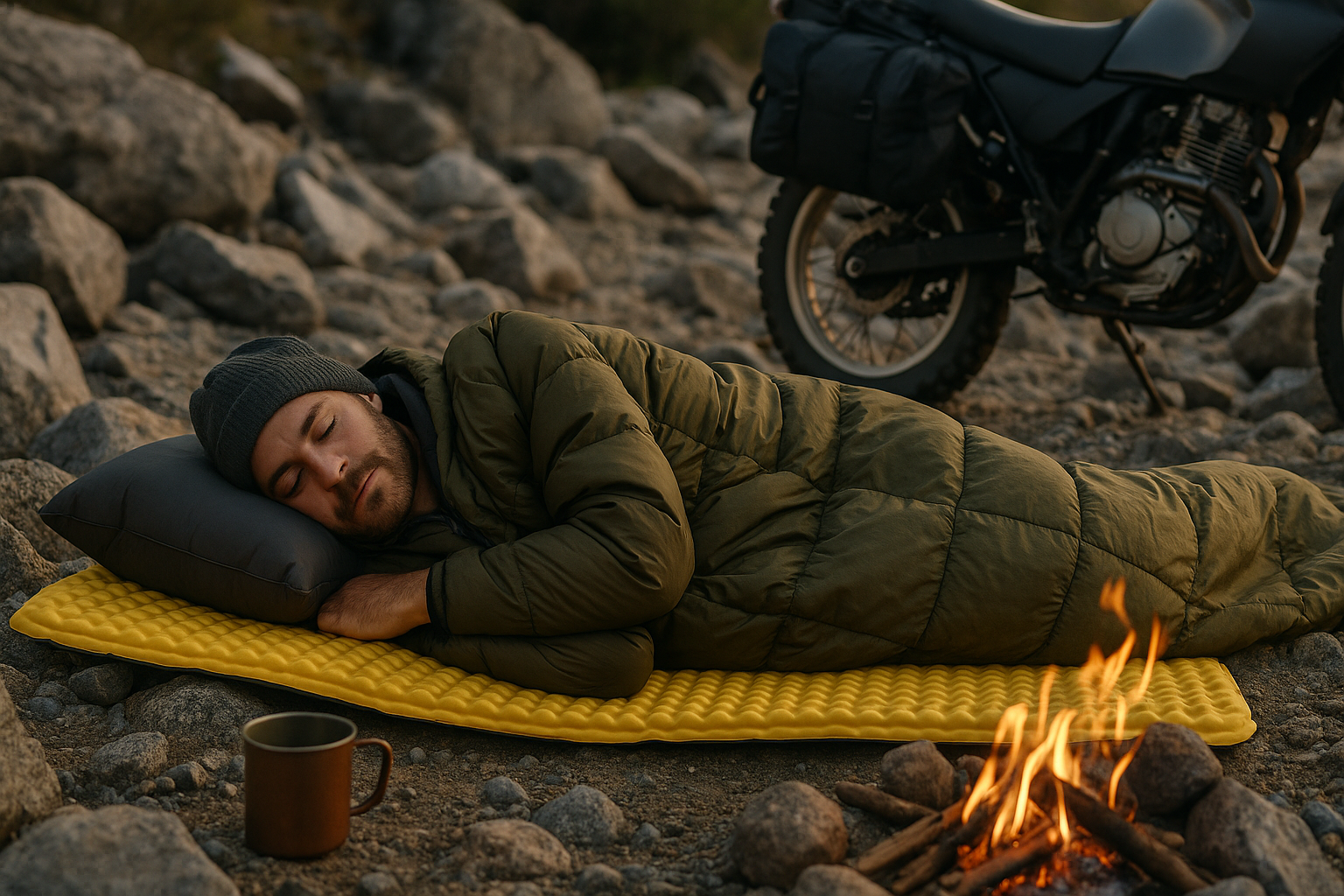Motorcycle camping sounds romantic — the open road, the hum of your engine, and the promise of sleeping under the stars. But when the sun sets and your campsite turns out to be nothing but hard-packed ground scattered with rocks, that romance can fade fast.
Without a solid plan, sleeping on uneven, rocky ground can leave you sore, sleep-deprived, and grumpy for the ride ahead. But with the right gear, smart packing strategies, and a few survival-minded tricks, you can create a comfortable bedroll for motorcycle camping, no matter how rough the terrain.
Here’s how to sleep well on rocks — without carrying the weight of a full camping mattress or cot.

 The Problem: Hard, Uneven Ground Can Wreck Your Rest
The Problem: Hard, Uneven Ground Can Wreck Your Rest
Sleeping on rocks isn’t just uncomfortable. It compresses your joints, restricts circulation, and causes hot spots that wake you up repeatedly. Poor sleep leads to sluggish reaction times, bad moods, and unsafe riding the next day.
Motorcycle campers often carry minimal gear — which means you need a solution that’s:
- Compact and lightweight (fits in panniers or dry bags)
- Easy to deploy after a long day’s ride
- Comfortable enough to keep you rested and safe

 Prepping the Ground: Making the Most of What You’ve Got
Prepping the Ground: Making the Most of What You’ve Got

Spend 5 extra minutes clearing sticks, sharp stones, and debris from your sleeping area. Use a riding boot or small trowel to shift loose rocks or dig a shallow, flat depression for your hips.

If you’re near leaf litter, pine needles, or moss, gather and spread them over the cleared area for a natural cushion. Be respectful — don’t strip the area bare or damage fragile plants.

Look for naturally flatter areas:
- Soft soil under pine trees
- Sand near a riverbank (away from high tide)
- Flat rock slabs covered in moss (if dry)

 Build a Smart Bedroll with Lightweight Gear
Build a Smart Bedroll with Lightweight Gear
Here’s how to pack a compact, comfortable sleep system for motorcycle camping:

These accordion-style pads are lightweight, durable, and can be trimmed to size. They provide insulation and a barrier against rocky ground.

If you don’t want a full-size inflatable pad, pack a short ultralight air mattress (like Therm-a-Rest NeoAir Short) or a sit pad for hips and shoulders. Combine it with a foam pad to save space and weight.

A lightweight ground sheet prevents moisture and dirt from soaking into your bedding. It also keeps small rocks from shifting under your pad.

Choose a sleeping bag with ample bottom insulation or a double-layer design that cushions from beneath. Mummy-style bags can be uncomfortable on uneven ground — consider rectangular or hybrid designs for more flexibility.

 Clever Hacks to Add Comfort Without More Weight
Clever Hacks to Add Comfort Without More Weight

Stuff extra clothes (like your jacket or riding pants) into a dry bag or pillowcase to create a makeshift pillow or bolster for your hips.

Place your riding jacket under your torso or knees to elevate pressure points. Use panniers or dry bags under your knees or calves to improve circulation.

If the ground is especially cold or damp, layer a space blanket or mylar sheet under your sleeping pad. This reflects body heat upward and blocks moisture.

 Emergency Bedroll Options (If You’re Truly Stuck)
Emergency Bedroll Options (If You’re Truly Stuck)

If you have no pad and the ground is rocky, build a thick layer of natural materials (leaves, pine needles, grass) under your ground sheet. Layer at least 4–6 inches for comfort.

Lay down your bike’s cover or a tarp as a moisture barrier. If you have extra clothes or gear bags, stack them under critical pressure points (hips, shoulders).

In emergencies, stuff trash bags with grass or leaves to create makeshift pads or pillows. Just be mindful of environmental impact — pack out all trash afterward.

 Real-World Rider Tips
Real-World Rider Tips
“I always carry a short inflatable pad just for my hips and shoulders. It weighs almost nothing and makes a huge difference on rocky campsites.” – Lena M., adventure motorcyclist
“I clear the ground and spread out my rain gear under my sleeping pad. It keeps moisture away and adds a little cushion.” – Mark R., solo rider
“If the ground is too rocky, I elevate my knees on a stuff sack filled with clothes. It helps circulation and feels like a proper bed.” – Jess W., overlander

 Sleep Position and Setup Hacks
Sleep Position and Setup Hacks

On uneven ground, angle yourself diagonally to distribute weight and reduce pressure points.

If you can, elevate your feet slightly using your riding gear or pack. This helps with blood flow and reduces swelling.

Wear a lightweight thermal layer to add warmth and padding. Avoid bulky layers that compress under your body weight.
 Conclusion: Sleep Smart, Ride Strong
Conclusion: Sleep Smart, Ride Strong
Motorcycle camping doesn’t have to mean sleepless nights on hard, rocky ground. With smart preparation, minimalist gear, and a few clever hacks, you can build a comfortable bedroll that keeps you rested and ready for the next ride.




Because a good night’s sleep is more than comfort — it’s your key to safe, enjoyable motorcycle camping adventures.

